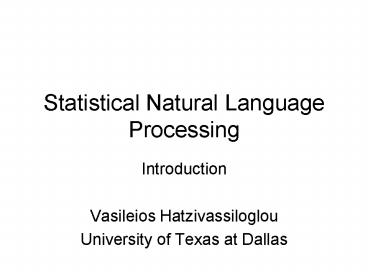Statistical Natural Language Processing - PowerPoint PPT Presentation
1 / 24
Title:
Statistical Natural Language Processing
Description:
Special Topics in Computer Science: Statistical Natural Language Processing ... How does Babelfish translate documents from German to English? ... – PowerPoint PPT presentation
Number of Views:244
Avg rating:3.0/5.0
Title: Statistical Natural Language Processing
1
Statistical Natural Language Processing
- Introduction
- Vasileios Hatzivassiloglou
- University of Texas at Dallas
2
Course information
- CS 6V81 003
- Special Topics in Computer Science Statistical
Natural Language Processing - Meets Monday and Wednesday
400515pm at ECSS 2.201
3
Instructor
- Vasileios Hatzivassiloglou
- Associate Professor, Computer Science
- Founding Professor, Bioengineering
- Research focus Discover knowledge from massive
amounts of raw data - data not the same as information
- information overload
4
Research Interests
- Text analysis, machine learning, intelligent
information retrieval, text mining,
summarization, question answering,
bioinformatics, medical informatics
5
Contact information
- Office hours Monday-Wednesday 530-630pm and by
appointment - Office location ECSS 3.406
- vh_at_hlt.utdallas.edu
- (972) 883-4342
- Web page To be announced
- Teaching Assistant TBA
6
Course goals
- Introduce the field of statistical natural
language processing (statistical NLP). - Describe the main directions, problems, and
algorithms in the field. - Discuss the theoretical foundations for modern
text analysis, information retrieval, and speech
understanding. - Involve students in hands-on experiments with
real problems.
7
Teaser
- How does Google determine which page to rank
higher among ones with similar content? - How does Babelfish translate documents from
German to English? - How does ETS score SAT essays without the
computer really understanding what is written?
8
Sample problems
- Extract information from political speeches or
blogs to find differences between Obama and Bush
or Clinton - Generate text using statistical dependencies that
looks like it was written by a human - Automatically process movie commentary and
reviews and assign a numerical score
9
Intended audience
- For students with or without prior knowledge of
natural language processing - Focus on large text collections and applications
emphasis on text mining - Coverage of machine learning background
- Limited algorithmic analysis / computational
complexity - Medium level of programming
10
Prerequisites
- None officially
- You should know
- Basic data structures (multidimensional arrays,
hash tables, binary trees) CS 5343 - Basic concepts of probability theory and random
variables CS 3341 - One high-level programming language
11
You need not know
- Machine learning
- Data mining (in general) or Text mining
- Text analysis / natural language processing
- Information retrieval
- Artificial intelligence
12
Course level
- Introductory graduate course (MS or
first/second-year PhD) - Maturity in programming and data structures as of
a CS senior - Ability (and interest in) accessing the primary
literature in a guided fashion
13
Course structure
- Lectures by the instructor
- Overview (4 sessions)
- Data preparation (2 sessions)
- Modeling Dependencies (5 sessions)
- Applications (2 sessions)
- Lexical Semantics (4 sessions)
- Hypothesis Testing (3 sessions)
- Similarity and Clustering (3 sessions)
- Multi-level Dependencies (2 sessions)
14
Course structure
- Student presentations of research projects or
papers (2 sessions)
15
Expected work load
- 2-3 homework sets given in February and March
- Two weeks to turn in each homework set
- Mid-term exam in mid/late March
- Student project / review of literature starts in
late March - Student presentations of research papers /
projects in the last week of April - Final exam on May 8
16
Student project
- Each student chooses to either
- Partner with another student and work together on
a short project of their choice (background
review, implementation, data collection,
reporting of methods and results) - Review a set of related papers from the primary
literature and summarize them for the class (2-3
papers chosen by the student with the advice and
consent of the instructor)
17
Grading
- Class participation 20
- Homework 30 (total)
- Midterm 10
- Project / literature review 20
- Final 20
18
Programming
- Each student selects their own programming
language (must be accessible to TA and run in the
UTD environment) - Examples C, C, Java, Perl, Python
19
Primary textbook
- "Foundations of Statistical Natural Language
Processing" by Christopher D. Manning and Hinrich
Schütze, The MIT Press, Cambridge, Massachusetts,
May 1999. - ISBN 0-262-13360-1
- 620 pages
- Available on Amazon.com for 66, Barnes and Noble
for 82
20
Background reading
- Statistics The elements of statistical
learning data mining, inference, and prediction
by Trevor Hastie, Robert Tibshirani and Jerome
Friedman, 2001. - Data structures and algorithms Introduction to
Algorithms, by Thomas H. Cormen, Charles E.
Leiserson, Ronald L. Rivest, and Clifford Stein,
2nd edition, 2001.
21
So what is it all about?
- Natural language processing is the study and
implementation of computer methods for
understanding and generating human language
(English, French, Urdu, etc.) - The discipline of linguistics studies human
language mechanisms (as opposed to products) in
general - Thus, NLP is often referred to as computational
linguistics
22
Human language
- An extremely complex communication system
- Many symbols (words), many constraints on what
words can go together, many complications on the
meaning of combinations of words
23
A comparison with a programming language
- A programming language has a small inventory of
words with pre-assigned meaning - A programming language has strict rules for
allowed sequences of words (syntax) - The meaning of each word is unique
- The meaning of a sequence of words is unique
(compositionality)
24
Levels of NL study
- Word formation from letters (morphology)
- Construction of longer units obeying class
constraints (syntax) - Interpreting the meaning of words (lexical
semantics) and longer units (semantics) - Complications from the environment and context
(pragmatics) - Acoustic properties (phonetics)

